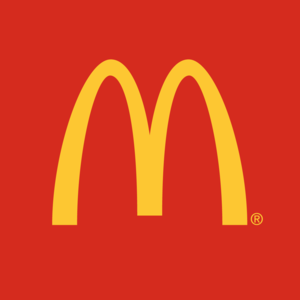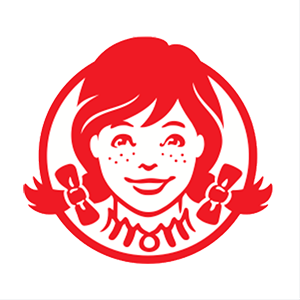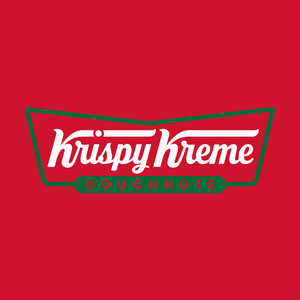
Krispy Kreme (DNUT)
We wouldn’t recommend Krispy Kreme. Its poor sales growth shows demand is soft and its negative returns on capital suggest it destroyed value.― StockStory Analyst Team
1. News
2. Summary
Why We Think Krispy Kreme Will Underperform
Famous for its Original Glazed doughnuts and parent company of Insomnia Cookies, Krispy Kreme (NASDAQ:DNUT) is one of the most beloved and well-known fast-food chains in the world.
- Estimated sales decline of 1.7% for the next 12 months implies a challenging demand environment
- Persistent operating margin losses suggest the business manages its expenses poorly
- Limited cash reserves may force the company to seek unfavorable financing terms that could dilute shareholders


Krispy Kreme is in the penalty box. We’d search for superior opportunities elsewhere.
Why There Are Better Opportunities Than Krispy Kreme
High Quality
Investable
Underperform
Why There Are Better Opportunities Than Krispy Kreme
At $4.30 per share, Krispy Kreme trades at 5.3x forward EV-to-EBITDA. Krispy Kreme’s valuation may seem like a bargain, but we think there are valid reasons why it’s so cheap.
It’s better to pay up for high-quality businesses with higher long-term earnings potential rather than to buy lower-quality stocks because they appear cheap. These challenged businesses often don’t re-rate, a phenomenon known as a “value trap”.
3. Krispy Kreme (DNUT) Research Report: Q3 CY2025 Update
Doughnut chain Krispy Kreme (NASDAQ:DNUT) fell short of the markets revenue expectations in Q3 CY2025, with sales falling 1.2% year on year to $375.3 million. Its non-GAAP profit of $0.01 per share was significantly above analysts’ consensus estimates.
Krispy Kreme (DNUT) Q3 CY2025 Highlights:
- Revenue: $375.3 million vs analyst estimates of $378.2 million (1.2% year-on-year decline, 0.8% miss)
- Adjusted EPS: $0.01 vs analyst estimates of -$0.05 (significant beat)
- Adjusted EBITDA: $40.6 million vs analyst estimates of $28.33 million (10.8% margin, 43.3% beat)
- Operating Margin: -1.9%, up from -4.2% in the same quarter last year
- Free Cash Flow was $15.54 million, up from -$22.88 million in the same quarter last year
- Locations: 14,851 at quarter end, down from 15,811 in the same quarter last year
- Market Capitalization: $645.4 million
Company Overview
Famous for its Original Glazed doughnuts and parent company of Insomnia Cookies, Krispy Kreme (NASDAQ:DNUT) is one of the most beloved and well-known fast-food chains in the world.
The company was founded in 1937 by Vernon Rudolph when he rented a small building in North Carolina to sell doughnuts to local grocery stores.
Since then, Krispy Kreme has evolved into an omni-channel business and acquired Insomnia Cookies, another revered brand, in 2018. Together, these two banners work harmonically to provide fresh sweets to its customers.
Krispy Kreme and Insomnia Cookies have an unwavering commitment to freshness and quality. At Krispy Kreme, each doughnut is made with the finest ingredients, ensuring a “hot-off-the-line, melt-in-your-mouth” experience, and at Insomnia Cookies, bakers work hard to create “CookieMagic”. In addition to its core menu items, Krispy Kreme serves a range of premium beverages, while Insomnia Cookies also offers ice cream, brownies, and cakes.
When entering Krispy Kreme’s stores, customers are greeted by the unmistakable aroma of warm doughnuts wafting through the air. The warm and inviting atmosphere, often adorned with the mesmerizing sight of doughnuts being freshly glazed through a see-through glass window, creates an immersive and joyful environment for customers.
On the other hand, Insomnia Cookies leverages a digital-first concept, using its popular app to facilitate in-store pickup and delivery orders. This channel accounts for over 40% of Insomnia Cookies’ sales.
4. Traditional Fast Food
Traditional fast-food restaurants are renowned for their speed and convenience, boasting menus filled with familiar and budget-friendly items. Their reputations for on-the-go consumption make them favored destinations for individuals and families needing a quick meal. This class of restaurants, however, is fighting the perception that their meals are unhealthy and made with inferior ingredients, a battle that's especially relevant today given the consumers increasing focus on health and wellness.
Some competitors that sell sweet treats include private company Dunkin’ as well as public companies Dutch Bros (NYSE:BROS), McDonald’s (NYSE:MCD), Starbucks (NYSE:SBUX), and Tim Hortons (owned by Restaurant Brands, NYSE:QSR).
5. Revenue Growth
A company’s long-term performance is an indicator of its overall quality. Any business can put up a good quarter or two, but many enduring ones grow for years.
With $1.53 billion in revenue over the past 12 months, Krispy Kreme is a mid-sized restaurant chain, which sometimes brings disadvantages compared to larger competitors benefiting from better brand awareness and economies of scale. On the bright side, it can still flex high growth rates because it’s working from a smaller revenue base.
As you can see below, Krispy Kreme grew its sales at a decent 8.5% compounded annual growth rate over the last six years (we compare to 2019 to normalize for COVID-19 impacts) as it opened new restaurants and expanded its reach.
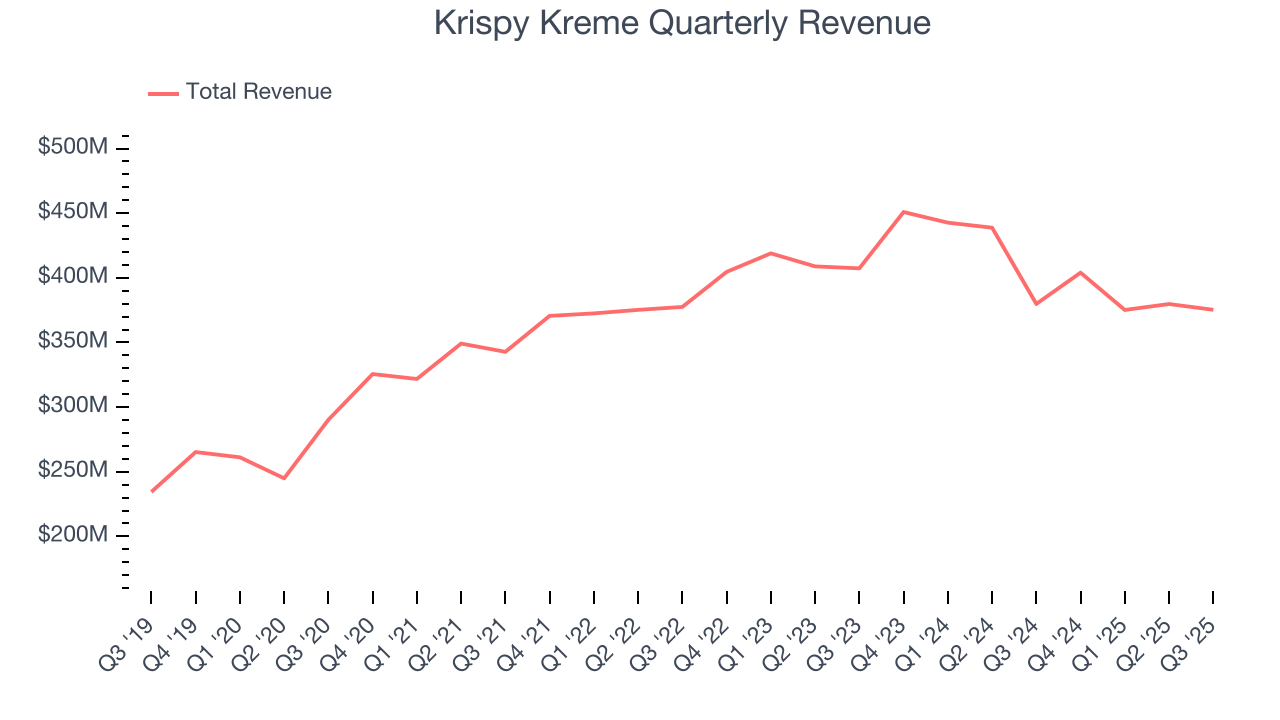
This quarter, Krispy Kreme missed Wall Street’s estimates and reported a rather uninspiring 1.2% year-on-year revenue decline, generating $375.3 million of revenue.
Looking ahead, sell-side analysts expect revenue to grow 1.3% over the next 12 months, a deceleration versus the last six years. This projection is underwhelming and indicates its menu offerings will face some demand challenges.
6. Number of Restaurants
A restaurant chain’s total number of dining locations often determines how much revenue it can generate.
Krispy Kreme operated 14,851 locations in the latest quarter. It has opened new restaurants at a rapid clip over the last two years, averaging 16.7% annual growth, much faster than the broader restaurant sector. This gives it a chance to become a large, scaled business over time.
When a chain opens new restaurants, it usually means it’s investing for growth because there’s healthy demand for its meals and there are markets where its concepts have few or no locations.
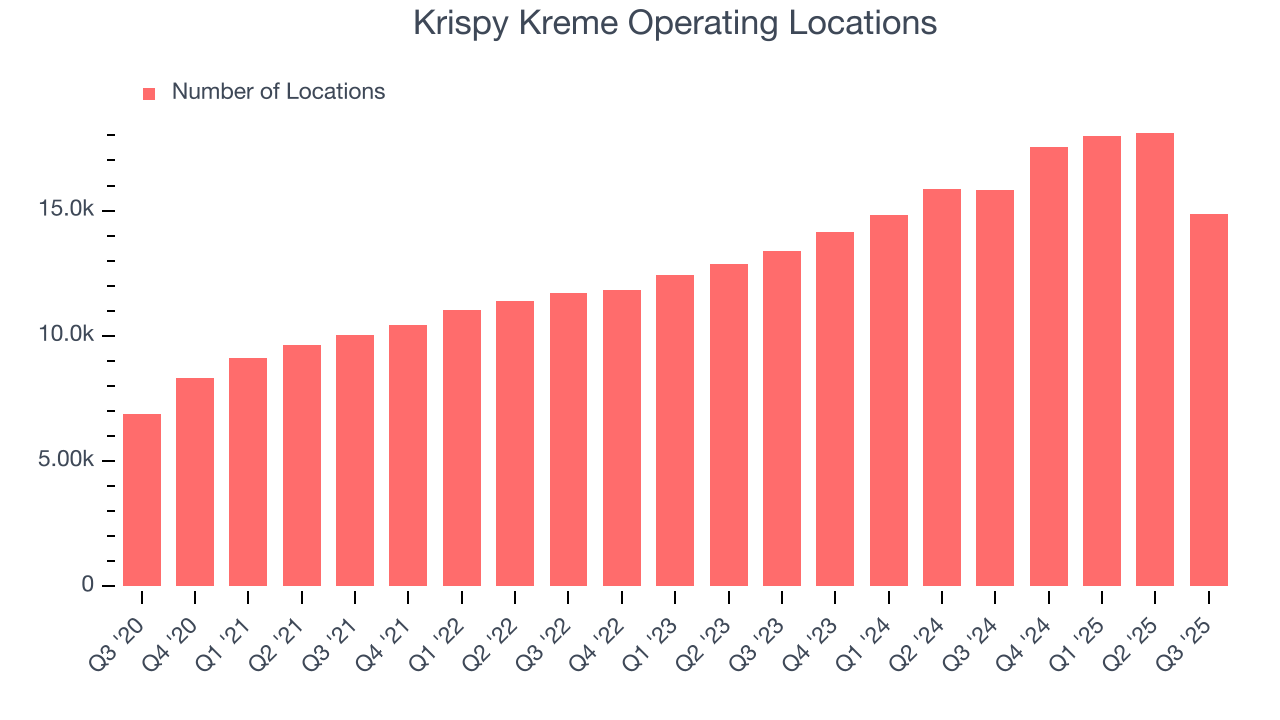
7. Gross Margin & Pricing Power
Krispy Kreme’s unit economics are higher than the typical restaurant company, giving it the flexibility to invest in areas such as marketing and talent to reach more consumers. As you can see below, it averaged a decent 25.5% gross margin over the last two years. That means for every $100 in revenue, roughly $25.52 was left to spend on selling, marketing, and general administrative overhead. 
Krispy Kreme produced a 22.2% gross profit margin in Q3, marking a 2.1 percentage point decrease from 24.2% in the same quarter last year. Krispy Kreme’s full-year margin has also been trending down over the past 12 months, decreasing by 5.1 percentage points. If this move continues, it could suggest deteriorating pricing power and higher input costs (such as ingredients and transportation expenses).
8. Operating Margin
The restaurant business is tough to succeed in because of its unpredictability, whether it be employees not showing up for work, sudden changes in consumer preferences, or the cost of ingredients skyrocketing thanks to supply shortages.Krispy Kreme has been a victim of these challenges over the last two years, and its high expenses have contributed to an average operating margin of negative 14.7%.
Looking at the trend in its profitability, Krispy Kreme’s operating margin decreased by 30.7 percentage points over the last year. This raises questions about the company’s expense base because its revenue growth should have given it leverage on its fixed costs, resulting in better economies of scale and profitability. Krispy Kreme’s performance was poor no matter how you look at it - it shows that costs were rising and it couldn’t pass them onto its customers.
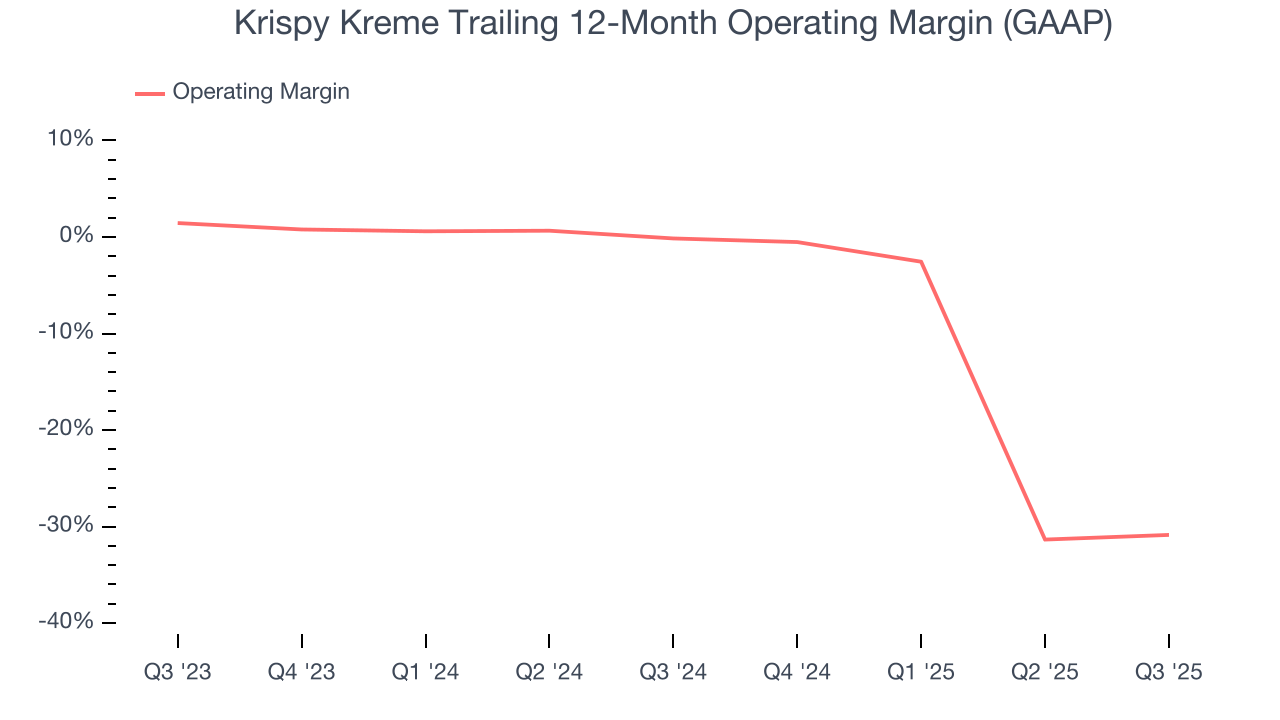
In Q3, Krispy Kreme generated a negative 1.9% operating margin.
9. Earnings Per Share
Revenue trends explain a company’s historical growth, but the long-term change in earnings per share (EPS) points to the profitability of that growth – for example, a company could inflate its sales through excessive spending on advertising and promotions.
Krispy Kreme’s full-year EPS turned negative over the last four years. We tend to steer our readers away from companies with falling EPS, especially restaurants, which are arguably some of the hardest businesses to manage because of constantly changing consumer tastes, input costs, and labor dynamics. If the tide turns unexpectedly, Krispy Kreme’s low margin of safety could leave its stock price susceptible to large downswings.
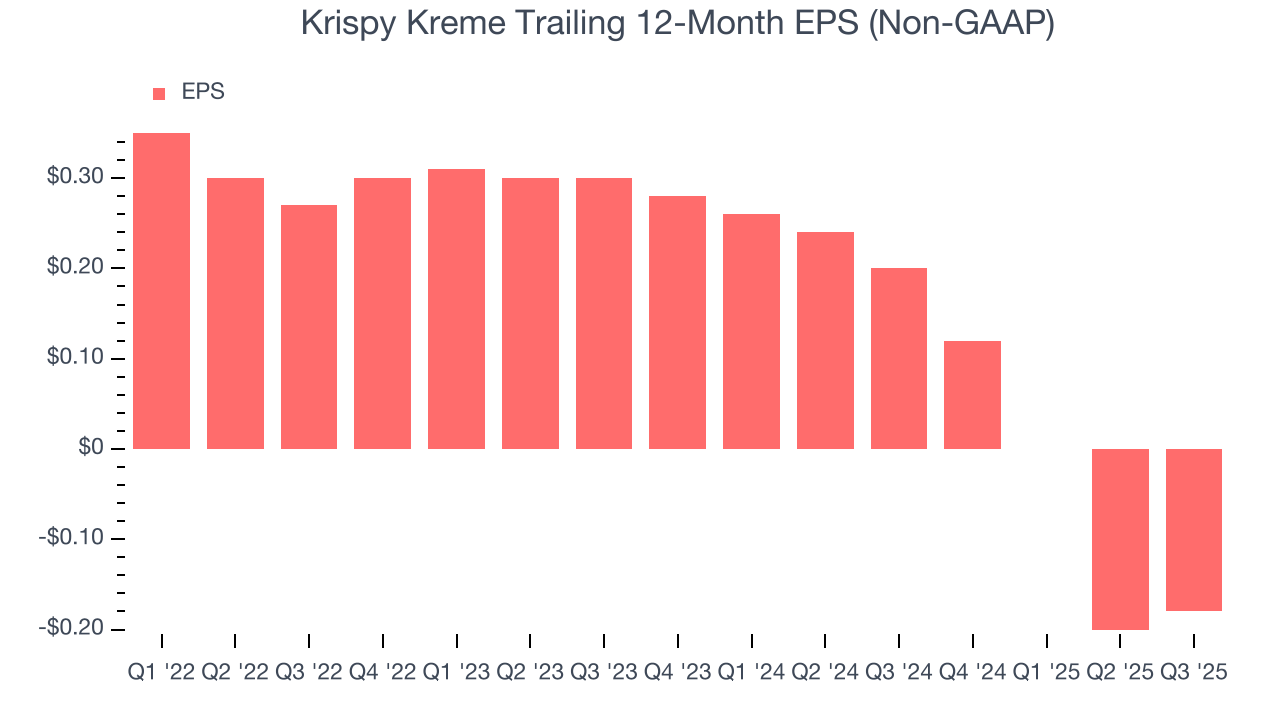
In Q3, Krispy Kreme reported adjusted EPS of $0.01, up from negative $0.01 in the same quarter last year. This print easily cleared analysts’ estimates, and shareholders should be content with the results. Over the next 12 months, Wall Street expects Krispy Kreme to improve its earnings losses. Analysts forecast its full-year EPS of negative $0.18 will advance to negative $0.15.
10. Cash Is King
If you’ve followed StockStory for a while, you know we emphasize free cash flow. Why, you ask? We believe that in the end, cash is king, and you can’t use accounting profits to pay the bills.
While Krispy Kreme posted positive free cash flow this quarter, the broader story hasn’t been so clean. Over the last two years, Krispy Kreme’s capital-intensive business model and large investments in new physical locations have drained its resources, putting it in a pinch and limiting its ability to return capital to investors. Its free cash flow margin averaged negative 6.1%, meaning it lit $6.11 of cash on fire for every $100 in revenue.
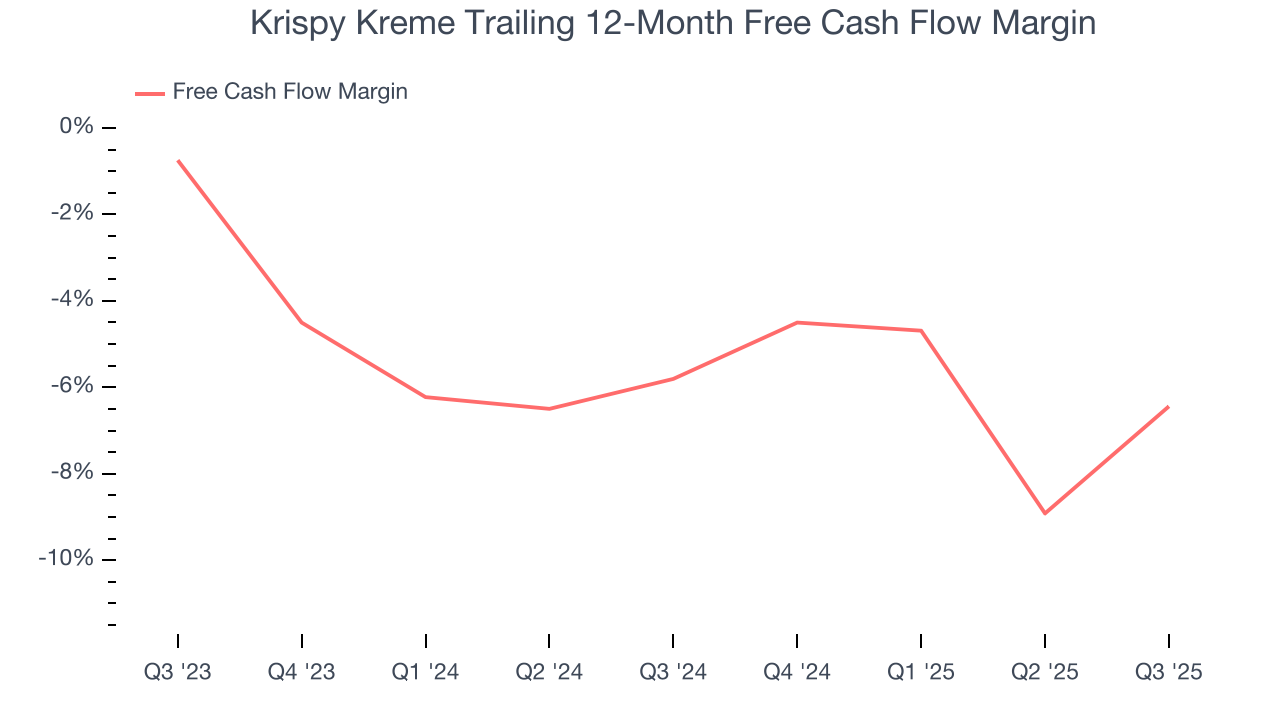
Krispy Kreme’s free cash flow clocked in at $15.54 million in Q3, equivalent to a 4.1% margin. Its cash flow turned positive after being negative in the same quarter last year, but we wouldn’t put too much weight on the short term because investment needs can be seasonal, causing temporary swings. Long-term trends are more important.
11. Return on Invested Capital (ROIC)
EPS and free cash flow tell us whether a company was profitable while growing its revenue. But was it capital-efficient? A company’s ROIC explains this by showing how much operating profit it makes compared to the money it has raised (debt and equity).
Krispy Kreme’s five-year average ROIC was negative 4.3%, meaning management lost money while trying to expand the business. Its returns were among the worst in the restaurant sector.
12. Balance Sheet Risk
As long-term investors, the risk we care about most is the permanent loss of capital, which can happen when a company goes bankrupt or raises money from a disadvantaged position. This is separate from short-term stock price volatility, something we are much less bothered by.
Krispy Kreme burned through $98.81 million of cash over the last year, and its $1.44 billion of debt exceeds the $31.15 million of cash on its balance sheet. This is a deal breaker for us because indebted loss-making companies spell trouble.

Unless the Krispy Kreme’s fundamentals change quickly, it might find itself in a position where it must raise capital from investors to continue operating. Whether that would be favorable is unclear because dilution is a headwind for shareholder returns.
We remain cautious of Krispy Kreme until it generates consistent free cash flow or any of its announced financing plans materialize on its balance sheet.
13. Key Takeaways from Krispy Kreme’s Q3 Results
It was good to see Krispy Kreme beat analysts’ EPS expectations this quarter. We were also excited its EBITDA outperformed Wall Street’s estimates by a wide margin. On the other hand, its revenue slightly missed. Zooming out, we think this quarter featured some important positives. The stock traded up 9.6% to $4.15 immediately following the results.
14. Is Now The Time To Buy Krispy Kreme?
Updated: December 4, 2025 at 9:45 PM EST
The latest quarterly earnings matters, sure, but we actually think longer-term fundamentals and valuation matter more. Investors should consider all these pieces before deciding whether or not to invest in Krispy Kreme.
We see the value of companies helping consumers, but in the case of Krispy Kreme, we’re out. Although its revenue growth was decent over the last six years, it’s expected to deteriorate over the next 12 months and its declining EPS over the last four years makes it a less attractive asset to the public markets. And while the company’s new restaurant openings have increased its brand equity, the downside is its relatively low ROIC suggests management has struggled to find compelling investment opportunities.
Krispy Kreme’s EV-to-EBITDA ratio based on the next 12 months is 5.7x. While this valuation is optically cheap, the potential downside is huge given its shaky fundamentals. There are superior stocks to buy right now.
Wall Street analysts have a consensus one-year price target of $3.83 on the company (compared to the current share price of $4.22).








